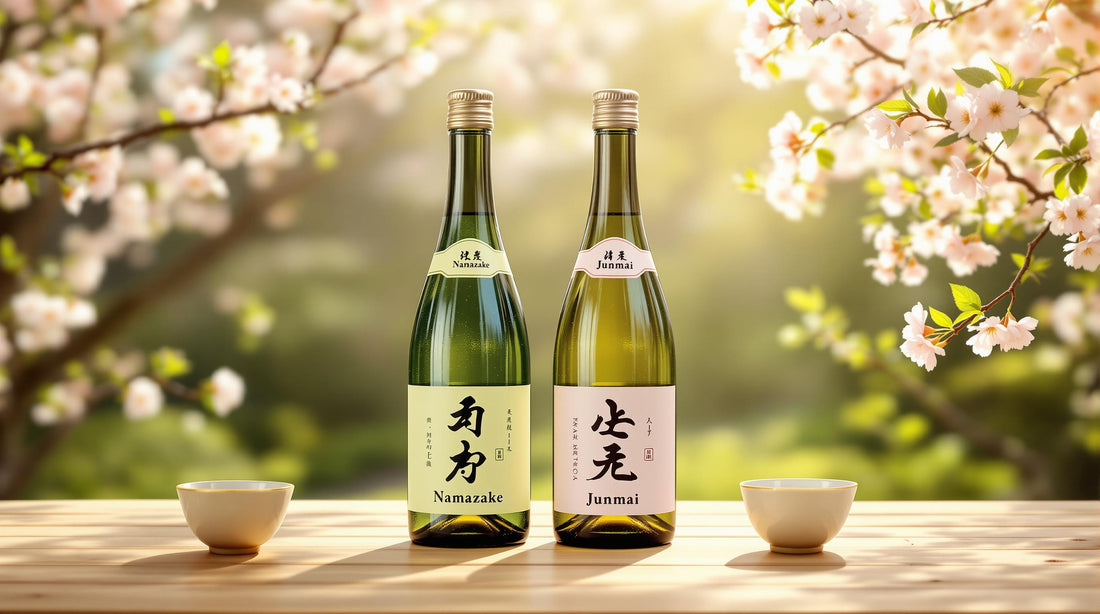
Namazake vs. Junmai: Spring Edition
Share
Namazake and Junmai are two popular sake styles perfect for spring. Namazake is unpasteurized, offering fresh, fruity flavors with a vibrant character, while Junmai is made with only rice, water, and koji mold, delivering rich umami and versatility. Here’s a quick comparison:
| Aspect | Namazake | Junmai |
|---|---|---|
| Pasteurization | Unpasteurized | Pasteurized |
| Flavor Profile | Fresh, fruity, vibrant | Rich, full-bodied, umami |
| Storage Requirements | Refrigeration required | Shelf-stable |
| Best Pairings | Light dishes like sushi, salads | Grilled fish, vegetables, hearty meals |
Namazake is ideal for those seeking something lively and fresh for spring, while Junmai provides a deeper, more robust option for a wide range of dishes. Both are excellent choices for seasonal celebrations.
Namazake Explained
Namazake: Definition and Features
Namazake, meaning "raw sake", is unique in the sake world because it skips the usual two rounds of pasteurization. This unpasteurized approach keeps it in a more natural state, giving it a distinct character and making it available mainly from winter to early summer [2].
There are various types of Namazake, each with different levels of pasteurization. However, they all share a fresh, lively quality that makes this sake style stand out [2].
Namazake Flavor
Thanks to its unpasteurized nature, Namazake offers bold, fresh flavors, often with a hint of effervescence and a long-lasting finish. These qualities set it apart from pasteurized sake [2].
"Shichi Hon Yari 'The Seven Spearsmen' Junmai Muroka Namazake exemplifies these characteristics with its subtle nose but blockbuster palate featuring abundant pear juice notes" [1].
Namazake Storage
Namazake must be refrigerated and consumed promptly to maintain its vibrant, fresh qualities. Its need for cool storage is one reason it’s traditionally available during the colder months, from winter to early summer. This makes it especially popular for spring festivities [2].
Its seasonal nature adds to its appeal, making it a favorite for spring celebrations. Namazake embodies the energy of the season with its bold, fresh profile, while Junmai offers a different charm, focusing on purity and versatility.
Junmai Explained
What Is Junmai?
Junmai, which translates to "pure rice", is made using just rice, water, and koji mold - no additional ingredients. This traditional brewing process involves extended fermentation, creating a sake with rich, layered flavors that highlight time-honored techniques.
What Does Junmai Taste Like?
Junmai sake stands out for its bold umami, balanced acidity, and full-bodied texture. It's a great option for spring, offering warmth and versatility. Its flavor profile pairs beautifully with seasonal dishes like grilled fish or fresh vegetables, making it a popular choice during this time of year.
"Junmai sake is a celebration of the brewer's art, showcasing the complexity and depth that can be achieved with just rice, water, and koji." - John Gauntner, Sake Expert, Sake World.
Types of Junmai Sake
Junmai sake includes subcategories like Junmai Ginjo and Junmai Daiginjo. These variations differ in rice polishing levels, offering a range of flavors from lighter, more delicate profiles to richer, more complex ones. This makes them versatile for pairing with various spring dishes.
A great example is the "Seikyo 'Live Heirloom' Omachi Junmai Ginjo Namazake", known for its smooth texture and flavors of honeydew melon and blueberry [1].
Namazake vs. Junmai Comparison
Differences Between Namazake and Junmai
Namazake stands out with its unpasteurized nature, delivering fresh and fruity flavors. In contrast, Junmai undergoes pasteurization, resulting in a stable profile with rich umami notes [2]. These qualities make Namazake a great match for light, fresh dishes, while Junmai pairs well with heartier meals.
Namazake and Junmai Comparison Table
| Aspect | Namazake | Junmai |
|---|---|---|
| Pasteurization | Unpasteurized | Pasteurized |
| Flavor Profile | Fresh, vibrant, fruity | Rich, full-bodied, umami |
| Storage Requirements | Requires refrigeration | Shelf-stable |
Spring Suitability
Namazake's lively, fresh character pairs beautifully with light spring dishes such as sushi and salads [1]. Its bright flavors highlight the season's fresh ingredients, making it a great choice for springtime meals.
Junmai, with its deeper umami and full-bodied texture, complements grilled fish, vegetables, and other spring dishes [1][2]. A standout example is the American Standard from Colorado Sake Co., which offers a robust profile that works equally well with grilled dishes and sushi [4].
For those looking to explore these options, The Sake Company provides a curated selection of premium Namazake and Junmai from artisanal producers. Whether you're drawn to Namazake's fresh vibrancy or Junmai's rich depth, the right bottle can elevate your spring dining experience.
sbb-itb-d9fb1bc
Related video from YouTube
Finding Namazake and Junmai
Now that you're familiar with the differences between Namazake and Junmai, let's talk about where to find authentic options for your spring celebrations.
Discovering quality Namazake and Junmai requires knowing the right sources. Many specialty sake shops and reputable online platforms now offer access to these traditional Japanese drinks.
The Sake Company

The Sake Company specializes in premium Namazake and Junmai from small-scale producers. They use temperature-controlled shipping to keep Namazake fresh, and their website includes helpful guides for beginners. You’ll find brewing insights, tasting notes, and storage tips - everything you need to enjoy sake at its best.
When choosing sake for spring, keep in mind that Namazake needs refrigeration and has a shorter shelf life. It’s usually most available from winter to early summer, aligning with traditional brewing cycles. Junmai, on the other hand, is more stable and can be found year-round.
The Sake Company works closely with artisanal breweries, offering a rotating selection of fresh Namazake and high-quality Junmai. Their dedication to proper storage and handling ensures you’ll get the best options for your spring gatherings.
Conclusion: Choosing Your Spring Sake
As spring nears, both Namazake and Junmai offer distinct experiences that align beautifully with seasonal celebrations. Knowing their unique traits can help you pick the right one for your gatherings.
Namazake, being unpasteurized, needs refrigeration to maintain its quality, while Junmai's pasteurization allows it to be stored at room temperature. Namazake is best served chilled to highlight its fresh and lively character. On the other hand, Junmai can be served at a range of temperatures, though chilling it enhances its crispness, making it a great choice for spring.
Namazake's bright and fresh flavors pair wonderfully with lighter dishes like sashimi [3]. Junmai, with its rich umami profile, pairs well with a wider variety of dishes, from grilled fish to seasonal vegetables [5].
Here are some factors to keep in mind when selecting your spring sake:
- Storage needs: Namazake is ideal if you have refrigeration and plan to enjoy it soon.
- Serving flexibility: Junmai offers more options for serving temperatures and has a longer shelf life.
- Food pairings: Namazake shines with light, delicate dishes, while Junmai works well with a broader range of flavors.
With these tips, you can confidently pick the sake that suits your spring festivities, whether it's the lively charm of Namazake or the versatile richness of Junmai.
FAQs
What is Namazake sake?
Namazake, or "raw sake", skips the usual pasteurization process in sake production [3]. It comes in three main types: Hon-Nama (completely unpasteurized), Nama-chozō (pasteurized once before bottling), and Nama-zume (pasteurized once before storage). Hon-Nama is the most fragile of the three and needs extra care when handling [2].
Is it safe to drink unpasteurized sake?
Yes, unpasteurized sake is safe as long as it’s stored properly and consumed quickly. Keep Namazake refrigerated, drink unopened bottles within six months, and finish opened bottles within a week [2].
For the best experience, buy from trusted sellers like The Sake Company, which ensures proper refrigeration. If you have a weakened immune system, it’s a good idea to consult a doctor before trying unpasteurized sake.
